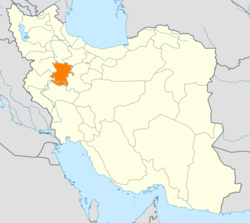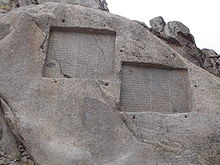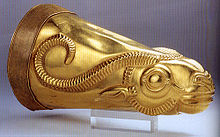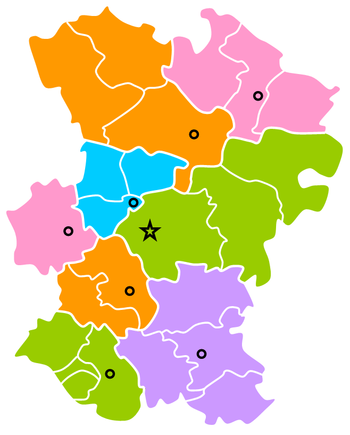- Hamadan Province
-
Hamadan Province
استان همدان— Province — Location of Hamedan within Iran Coordinates: 34°47′54″N 48°30′53″E / 34.7982°N 48.5146°ECoordinates: 34°47′54″N 48°30′53″E / 34.7982°N 48.5146°E Country  Iran
IranCapital Hamedan Counties 8 Area – Total 19,368 km2 (7,478 sq mi) Population (2006)[1] – Total 1,703,267 – Density 87.9/km2 (227.8/sq mi) Time zone IRST (UTC+03:30) – Summer (DST) IRST (UTC+04:30) Main language(s) Persian
Azeri
Luri
Laki
KurdishHamedan Province (Persian: استان همدان, Ostān-e Hamadān ) is one of the 31 provinces of Iran. Its center is Hamedan city. The province of Hamedan covers an area of 19,546 km². In the year 1996, Hamedan province had a population of approximately 1.7 million people.
Other major cities of Hamedan province are: Toyserkan, Nahavand, Malayer, Asad Abad, Bahar, Razan, Kabudrahang.
Contents
Geography
The province lies in an elevated region, with the 'Alvand' mountains, running from the north west to the south west. These are part of the Zagros mountain range of Iran.
Hamedan enjoys temperate warm summers and relatively cold winters.
Demographics and languages
Malayer county has a population of around 310,000 people, Nahavand county has a population of 200,000 people, Hamadan County has a population of 700,000 thousand people, Tooserkan and Asadabad each have a population of around 150,000, Kabutare ahang, Razan, and Bahar each have a population of between 120,000 - 140,000 people. Kurdish, Azeri, Luri, and Persian language are spoken amongst the people of Hamadan Province, where Azeri is more popular in northern and eastern areas and Kurdish are mostly spoken in the west. In the central parts likeHamadan County and parts of Tooserkan, Persian is more common. Luri is spoken in southern parts of Malayer country and all of Nahavand [3].
According to the survey of 1997, the population of province was 1677957. Based on official statistics of 1997, the population of the city and Hamadan county was 563444 peoples. In Hamadan county (which mainly includes Hamadan city), 80% of the people identified their language as Persian, 12% Azeri and 8% Luri, Kurdish and Laki.[2]
In the counties of Hamadan province, the population of Nahavand was 184160 (in 1997) with approximately 99% speaking Luri and Laki.[2] The population of Malayer in 1997 was 297062 and approximately 75% speak Persian, 15% Luri and Laki and 10% others. In 1997, the population of Tooserkan county was 118945 and the majority of the population is Luri and Laki.[2] In Asadabad county, the population was 110077 (in 1997) and 63% were Persian, 14% Azeri, 19% Kurdish and 4% Luri and Laki.[2] In Kabudarahang, the population in 1997 was 152318 with 90% speaking Azeri, 5% Persian and another 5% Kurdish.[2] In Razan county, the population was 123790 (in 1997) with 99.47% of the residents speaking Azeri and 0.53 speaking Kurdish.[2] In Bahar country was 127600 with 86.3% speaking Azeri, 7.9% speaking Kurdish, 4.5% speaking Persian and 1.3% speaking Luri.[2]
History
Hamedan province is one of the most ancient parts of Iran and its civilization. Relics of this area confirm this fact. Today's Hamedan is what is left of Ecbatana, The Medes' capital before they formed a union with the Persians. The poet Ferdowsi says that Ecbatana was built by King Jamshid.
According to historical records, there was once a castle in this city by the name of Haft Hessar (Seven Walls) which had a thousand rooms and its grandeur equalled that of the Babylon Tower.
The structures of city are related to Diya Aku, a King of the Medes from 700 BC. According to Greek records, this territory was called 'Ekbatan' and 'Hegmataneh' by this King, thus transformed into a huge capital.
During the Parthian era, Ctesiphon became capital of Persia, and Hamedan became the summer capital and residence of the Parthian rulers. After the Parthians, the Sassanids constructed their summer palaces in Hamedan as well.
In the year 633 when the war of Nahavand took place and Hamedan came into the hands of the invading Arabs, at times it thrived and at times it declined and witnessed hardships. During the Buwayhids, it suffered plenty of damages. In the 11th century, the Seljuks shifted their capital from Baghdad to Hamedan once again.
The city of Hamaden was always at risk during the rise and fall of powers. It was completely destroyed during the Timurid invasion. But during the Safavid era the city thrived once more. In the 18th century, Hamedan surrendered to the Ottomans, but Hamedan was retaken by Nader Shah Afshari, and under the peace treaty between Iran and the Ottomans it was returned to Iran.
The city of Hamedan lay on the Silk Road and even in recent centuries enjoyed good prospects in commerce and trade being on the main road network in the western region of Iran.
According to local Jewish traditions, the City of Hamedan is mentioned in the Bible, as the capital of Ancient Persia in the days of King Ahasuerus in the Book of Esther. It was then known as Shushan. The Tombs of Mordecai and Esther are located in modern-day Hamedan.
Hamedan today
Administrative divisions
Hamedan Province KabudarahangGol TappehShirin SuSardrudHamadanQorveh-eDarjazinFameninSharaJowkarZandSamenTuyserkanQolqol RudKhezelZarrinDashtGiyanLalejinSalehAbadThe province has a population of over 1,820,000 million. (As of 2008) The province is divided into 8 Shahrestans (≈counties), which in turn are divided into 23 Bakhshs (≈districts) in total. These divisions are shown on the map as well as the center of each county and the neighbor provinces.
Colleges and universities
- Hamedan Medical University
- Bu-Ali Sina University
- Hamedan University of Technology
- Islamic Azad University of Hamedan
- Payam Noor University of Hamedan
- Payam Noor University of Bahar
- Payam Noor University of Kabootar Ahang
- Payam Noor University of Toyserkan
- Payam Noor University of Nahavand
- Payam Noor University of razan
- Islamic Azad University of Toyserkan
- Islamic Azad University of Nahavand
Attractions
The Cultural Heritage of Iran lists 442 sites of historical and cultural significance located in Hamedan, thus making the province a rich one in terms of historical attractions.
Some of the most popular sites are:
- Tomb of Baba Taher the poet
- Ganj Nameh inscriptions of Darius The Great
- Tomb of Esther and Mordechai
- Ali Sadr (Ardeles) cave
- Tomb of Avicenna
- Waterfall of Ganjnameh
- Stone Lion of Hamedan
- Abass Abad jangle(Baugh)
- Qorban Building
- Alavian Tomb
- Eram Park
- Hegmatane (Ekbatan) City of 5000 years ago
- Imam(pahlavi) Sq
- Alvand Mountain
- Grand Bazzar of Mozafarieh
References
External links
- Official website of Hamedan Governorship
- Hamedan Cultural Heritage Organization
- Official website of Hegmataneh (Ecbatana)
- Hamadān entries in the Encyclopædia Iranica
- Photos from around Hamadan province -Includes Alisadr Cave and Hamadan City.

Kurdistan Province Zanjan Province Qazvin Province 

Markazi Province  Hamadan Province
Hamadan Province 

Kermanshah Province Lorestan Province  Hamadan Province
Hamadan ProvinceCapital Hamadan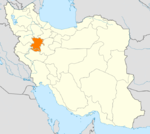
Counties and Cities Famenin CountyFameninKabudarahang CountyKabudarahang · Gol Tappeh · Shirin SuSights Ganjnameh • Shrine of Habakkuk,Toyserkan • Hamedan Stone Lion • Ali Sadr Cave • Hamedan Museum of Natural History • Noshijan fire temple,Malayer • Shrine of Esther and Mordechai,Hamedan • Baba Taher Mausleum,Hamedan • Avicenna mausoleum,Hamedan • Emamzadeh Yahya,Hamedan • Alvand ski resort • Pirsolayman lagoon • Median capital of Hegmataneh,Hamedan • Ecbatan dam • Geyan lagoon • Baba-pireh shrine • Ecbatana •Provinces of Iran Alborz · Ardabil · Bushehr · Chaharmahal and Bakhtiari · East Azerbaijan · Isfahan · Fars · Gilan · Golestan · Hamadan · Hormozgan · Ilam · Kerman · Kermanshah · Khuzestan · Kohgiluyeh and Boyer-Ahmad · Kurdistan · Lorestan · Markazi · Mazandaran · North Khorasan · Qazvin · Qom · Razavi Khorasan · Semnan · Sistan and Baluchestan · South Khorasan · Tehran · West Azerbaijan · Yazd · Zanjan
Categories:
Wikimedia Foundation. 2010.

